My son is, by nature, a cheerful person. When he was in high school studying world history, there was a unit on the rise and fall of empires, with inevitable comparisons to the United States. During that time, he would come home uncharacteristically dejected and quiet. One afternoon, he seemed especially sad. I asked him why. He thought for a moment, choosing his words carefully. When he looked up again, his eyes brimmed with tears as he said, “It’s just that in previous times, the empires that collapsed didn’t take the entire natural world with them.”
I must have muttered the requisite You’re right and I’m so sorry but really, what the hell do you say when your child recognizes that Life itself is threatened and no one in charge seems to care? I have carried this conversation like a stone in my heart ever since. It has become the koan at the core of my life.
In Nature, everything is designed to ensure the survival of the Whole. How did we humans step outside of Nature’s design? The only three reasons I know of for murder and suicide are illness, addiction and trauma. We’re suffering from all three. Most of us alive today are children of the atomic age and so cannot remember a time when the future mattered enough not to risk it. But it goes back farther than that. Centuries of compromised nutrition due to erosion, monocropping, and, in recent decades, industrial farming, and overuse of antibiotics have robbed us of the health we need in order to make competent decisions. Multi-generational trauma has eroded our capacity to envision a vibrant future and live accordingly. Empire, power, greed and gambling are addicting and now it seems the survival of Life on Earth is on the table. It is significant that men are leading this reckless charge (more prominently than women): we would do well to understand what makes males more prone to distorted judgment (along with heart disease, autism, dyslexia and violence) and we need to ask ourselves how we as parents – especially those of us who are mothers– have failed to ingrain in our children a love of the Earth and the mandate to protect the Future.
Why are we participating in our own slow murder, and the murder of all that we love? My outrage, my grief, cannot be met by marching, signing petitions, voting, or calling my representatives. Though I still do many of these things, I find it far more comforting to talk to Nature directly and do my best to listen. In 2012 I bought a beautiful, degraded piece of land here in Mendocino County (Northern California). Before the work of restoration and remodeling began, I sat on ‘my’ hill and listened. It was one of the first times I had had a sense that the land was, indeed, speaking to me and that I could understand what she said. She told me that there were five permanent underground springs and two intermittent ones. I sketched their locations in my journal. When my contractor insisted that he knew the proper location for the construction of a new greenhouse, I told him that the place he suggested was between two springs that the land had showed me. But I was a newcomer to the area, and he insisted he knew best, so I yielded. Three years later, it cost countless remorse-filled sleepless nights and money I did not have in order to build a retaining wall and a system of stepped pools and drains to handle the accumulated water from the springs I had been shown.
 “Edgewalker Sanctuary”, 10 Mile River, Ft. Bragg, Ca
“Edgewalker Sanctuary”, 10 Mile River, Ft. Bragg, Ca
I look at the forests on ‘my’ land and in this beautiful place that I live and can’t help but feel that the trees are disappointed. We have failed them with our ravenous logging, clear cutting and massive lumberyards. We have failed them with our roads that hasten erosion by changing drainage patterns, and with our fences that impede the animals whose presence is integral to forest health. We drown out birdcalls with our machines, and ravage insects and microbes with our mania for poisons.
The reforestation begins in our bellies. The ph of our mouths must be slightly alkaline, so that the bones of our words will be strong. One begins with a pinch of dust on the tongue, savoring its grit, grateful for the minerals scraping the backs of our teeth. This, too, is art. Slowly, a flicker of recognition will come that feeds the heart without damaging the patience of trees. And while we taste the dust that we will become, there will be no rain. Or too much rain. The wind has been telling us this for years, though we have not listened. There will be no more being-OK of things, no going back, at least in our lifetimes – only more droughts, more flooding, more mourning, more demagogues. We will learn to do whatever the wind asks of us, whatever the rain might have asked if it had been in its right mind, and had arrived in time, in manageable or predictable amounts. There will be signs that the trees are listening, and that the whales and the deer can hear our praises. Just last Tuesday the whales came to ‘my’ cove and seemed to listen as I played my singing bowls to them – at first a mother and calf, then another adult. The three of them stayed all afternoon, so close to the cliff I could hear them exhale, that great rush of breath that sends a misty plume shooting into the sky. As the music continued, they rolled on their sides and waved their flippers. When I came indoors at twilight, they were still there. Coincidence? Perhaps. Then again, how else can animals communicate with humans except by interacting with them in ways that demonstrate intentionality?
In 2015 a friend said, “When things get really bad, we should go into the mountains and make art for five hundred years, like they did in ancient Japan.” I pictured monks in pristine forests building shrines and practicing calligraphy. I liked the ring of it then, and the idea has stayed with me. I told myself I would recognize when the moment came to activate such a plan — at the time it all still seemed at arm’s length. Now that the Great Barrier Reef is actively dying, and extreme weather is commonplace; now that Trump and his cronies are bulldozing the EPA, banking regulations, health care, civil rights, the arts, the media, internet access and diplomacy, well, the emergency is undeniably underway. Our art-making must begin in earnest, though I have not fled to the mountains, but to the sea.
Refugees of weather and war have, by some estimates, surpassed 65 million with projections for climate refugees alone to reach 150 million by 2020;1. Some refugee children in Sweden have lost the will to live but do not die. As happens with plants that have been too long without soil, the trauma of extended uprooting has pushed these teenagers into impenetrable comas. One day they are fine, the next day they are on life support. This new illness has been named Uppgivenhetssyndrom — resignation syndrome.;2 We might consider that the children’s resignation, their apathy, mirrors that of the adults who have failed them, in particular the governments of the countries that have not (yet) fallen into chaos. Mahmoud Darwish’s words appear like images from a dream: Longing has a country, a family, and an exquisite taste in arranging wildflowers. It has a time chosen with divine care, a quiet mythical time in which figs ripen slowly and the gazelle sleeps next to the wolf in the imagination of the boy who never witnessed a massacre.3 In my guilty heart, I give silent thanks that my son did not fall into comatose despair. Given the sheer numbers of refugees swelling humanity’s edges, it may only be a matter of time before the disease of resignation to a futureless future becomes an epidemic.
John Paul Lederach, considered to be the father of modern day peacebuilding, says that it takes about as long to get out of a conflict as it took to get in. In that case, five hundred years is just the beginning. I imagine that’s how long it will take for us to return to ourselves and to the Earth’s embrace, for the trees to trust us, for the wind and the ice and the animals to believe us. We must use our art to bow in gratitude. Though this is a plausible first step in repairing our tattered relationship with the Earth, five hundred years of droughts and floods is a very long time for humans. I remember the words of the rabbi one Passover. He was speaking of Moses and the 40-year trek of the Israelites through the desert. “There is only the long way,” he told us. “No shortcuts.” I am grateful for this wisdom. It has become one of my mantras. Only the long way. No shortcuts. Five hundred years on our way to unwinding the spiral of the millennia that we humans have been enslaving the Wild and each other. How does a millennial time span reshape our lives? How does it bend each individual life span to respond to the instantaneous synapses, chemical reactions, bacterial and microbial telegraphy while simultaneously diluting the now until it leaves barely a homeopathic trace in Deep Time? It is essential to yield to this reconfiguration so that it can begin to reshape us now. Contrary to what we have been told, Time is not money. It is the sensory experience of the rhythms of Life. Like Moses, we will practice the art of the impossible. It may take five hundred years to learn it. Until now, we have reserved our practice of the impossible to mean conquering natural limits. Now it is time to add the understanding that it’s impossible for us to continue as we are.
Here is what was, apparently, impossible for me last fall: Like so much of what we must repair, it starts with a blunder, a cruelty. I had been reading in bed, reviewing a manuscript I had just finished, wanting to complete the reading in one go. (It’s the story of two men who have been crushed by modernity, but whose love for the natural world revives them. The irony was not wasted on me then or now.) I finished at 2:30 a.m. – too late to sleep, too early to stay up until dawn. As I finally reached over to turn out the light, a mouse scurried across my small room and skittered past my bed, ducking beneath the hem of the comforter that trailed on the floor. At first I didn’t see where she had gone because I was too busy leaping to my feet and shouting at her, “NO! NO! YOU CAN’T BE HERE!” I ran for the broom, switched on the overhead lights and slid the dimmer to its brightest position. I pulled the nightstand away from the wall, and the mattress. No mouse. I eased the dresser towards the middle of the room, shouting the whole time, and there she was, cowering in the corner, looking up at me with the full beauty of her wildness and the intelligence of all the mice of all time, unblinking and terrified as our eyes met. Poised with my ludicrous broom, I saw in her terror a seed of acceptance that shamed me. I asked myself out loud, Is this any way to behave in a drought? I checked my breathing, relaxed my shoulders and lowered my voice. Where are my manners? I asked the mouse, and myself, and added Please forgive me. I looked away, then back at the mouse. I’m sorry, I told her, but please understand that you cannot be here. I thought for a moment and decided to tell her the rest of the truth. You mice chew things up and poop all over, and I can’t live with that because I need to sell this place and move to the ocean, where I belong. There are lots of safe places outside for you to be. Maybe not as warm, but safe nonetheless. I’m so sorry. I leaned over, opened the door and out she went. As she climbed over the ridge of the threshold, her hips widened a little, and as she disappeared over the edge of the deck, her muscles rippled beneath her fur, which was a lustrous light brown edged in black, with black around her ears. Slowly, I pushed my dresser back into the corner against the wall. Later, a friend told me that he, too, had had to usher some mice outside. He and his wife had returned from a trip to find a nest filled with young in their bedroom. Unlike me, they had had the good manners to say to the mice, “I know, the waxing moon is nearly full and the owls are hungrily calling, but don’t worry. We’ll move you to a safe place.” They had searched outdoors for a protected spot and gently relocated the whole nest, praying for the mouse family’s wellbeing. I reminded myself that I was still learning, that at least I had calmed down and the mouse had left, uninjured — that there’s only the long way. I sheepishly told myself that ‘my’ mouse had a good chance of reaching the protection of the nearby hedge, or a corner under the deck, before any owls could swoop down and catch her, but the metallic taste of shame lingered on my tongue.
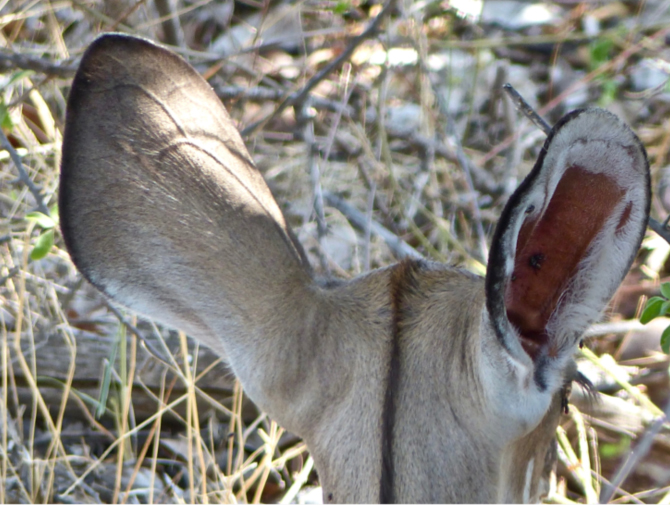 Baby Nyala waiting for her mother under a tree, Mashatu, Botswana
Baby Nyala waiting for her mother under a tree, Mashatu, Botswana
On the eve of the 2016 U.S. presidential election, I heard a talk by a Peruvian teacher who said, A cancer cell is a cell that has lost its connection and communication with the rest of the body. When we break reciprocity with the Earth, we become a cancer. I remind myself that the nature of every dilemma reveals its cure. Since my time working in Liberia during the early 2000’s, my friends and I have referred to this as the Wisdom of the Breakdown: Just as in the wild, antidote plants grow next to poisonous ones, the antidote to our murderous behavior lies at our feet. The severe depletion of our soils has caused an epidemic of digestive—and therefore—immune disorders while our ravaged oceans will soon mean global collapse of fisheries along with potential oxygen depletion that could threaten all life on Earth.4 The first step to reconnection with Nature is to show respect by reestablishing communication — to observe, acknowledge, listen and respond. And look: the root of the word culture derives from the Latin colere, which means to inhabit, to cultivate, to honor or worship. In Middle English, it meant place tilled.5 Culture and cultivation are rooted in the Earth. Life, water and soil are inseparable. Remembering where we came from will free us in unimaginable ways because, by so doing, we will be part of the Whole once again.
Cultures that have ‘bought in’ to Western thinking have been taught to ignore any personal connection to the Earth on pain of ridicule or death. ‘Free trade’ means permission to sell the future for profit today. But just one milligram of curiosity and a pinch of gratitude is all it takes to enter into dialogue with the Earth, whether or not you ‘believe’ in climate change or have experienced Gaia as sentient. Intimacy, in addition to its romantic connotation, can be defined as seeing and knowing someone or something deeply. Why are we no longer intimate with the Earth? What’s wrong with sensually, or even sexually, loving the Earth? Why is that considered obscene and the Pacific Gyre is not? We are all, literally, being sickened by those who insist that we who love the Earth must constantly ‘prove’ that She is generous, wise and miraculous. But “proof” is everywhere. Miracles are the essence of Life. Without them we wouldn’t be here. We breathe in and breathe out and live another day. We make love and a child forms. What are these if not miracles?
We have created a culture where it is dangerous to live from the truth of the Earth’s wise aliveness. Bacteria communicate continuously, inside and outside of our bodies. The mycelia that connect most plants share nutrients and warn each other of danger. Sightless microbial predators in the soil can sense each other’s presence from up to two miles away.6 Jane Goodall has described how she wept during a visit to a science lab filled with tormented Chimps in cages, and one of them reached through the wires of his cage to wipe away her tears.7 What kind of madness is it to doubt that the Earth and her myriad life forms can and do communicate with us when they are in constant communication with each other? Certainly it’s a madness that merits its own category in the DSM III: Hubristic Suicidal Gaiaphobia.
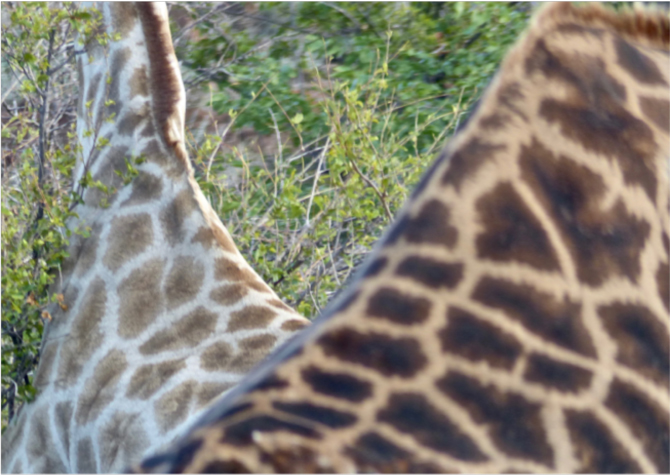 Fractal patterns: Giraffes at Ruaha National Park, Tanzania
Fractal patterns: Giraffes at Ruaha National Park, Tanzania
A healthy, resilient society is a biomimetic one: fractal, multi-dimensional, dependent on interconnection with multiple, self-similar, random and often incomprehensible invisible, unknown and unknowable elements. This is why the remaining intact remnants of once-vast ecological splendor matter. It is why indigenous languages, stories, rituals, songs and technologies matter as well, for these are the cultural algorithms that translate Life’s healthy fractal structures to human understanding, enacted in relationships for us to model our lives on, with each other and with the natural world. To be clear: the world’s remaining beleaguered indigenous cultures have their own inherent beauty and sovereign right to exist, on their own terms, for which no justification is necessary. Nevertheless, these precious, intact ways of being are of especially great consequence now. Their vast knowledge, both practical and esoteric, understands what we in the West do not: how to live in balanced humility with the natural world. In the words of a Navajo colleague: “Natural Law was here before and will be here after we’re gone. Western law was not here then and will not last.”
Evolutionarily speaking, this means that the ultra-wealthy are actually, with few exceptions, dismally unsuccessful because they are utter failures at symbiosis, truly a burden on society and the natural world. Most of the very poor understand how and why to weave themselves into a vast and deeply personal web of relationships that go beyond survival to include shared meaning and vitality on a scale unknown to most of the world’s one percenters. This is not to romanticize suffering and poverty. This is to view it through a biomimetic lens. The dominance of wealth as a goal and as a socio-economic measure of success is a death knell for all the natural systems the world depends on. Odd, then, that disproportionate wealth confers disproportionate power to continue the damage. In Nature, true power is held within the infinitesimal and the invisible (think microbes, and underground mycelia). Dominance behavior is neither a natural nor an effective way of being. In Nature, dominance, like fire, has a specific, focused — and limited– purpose. Apex predators such as lions and sharks are not ‘winners’ and their prey ‘losers.’ Each is essential to the balanced functioning of the Whole. The notion of survival of the fittest is misleading because it has been de-contextualized and spun to mean that being at the top is the best place to be. But being at the ‘top’, in the human context, means being without a functional niche — a very dangerous place, indeed. Predators only survive if there is prey. Total dominance leads to starvation. (Imbalance causes extinction. Complexity (not complication) creates vitality. Fractals, webs and symbionts are Nature’s insurance policy.)
People like Trump, the Koch brothers, Mugabe, Putin, Carlos Slim and other bandits are the suicide bombers of Life on Earth. No need to wait until the afterlife for their reward. They can grab pussies, silence opposition and bankrupt countries with equal impunity right now. But they cannot hide behind the curtain of power indefinitely because it is not made of whole cloth. It is just a fragment, and a fragment cannot survive much less thrive on its own. Without the servants, the home security companies, the fire departments, the emergency room doctors, the car manufacturers and minimum wage factory workers, and yes, the miners and the Earth they gouge, the 1% would perish–which they will, along with everything else. A healthy, resilient culture is one whose presence benefits at least as many elements as it depends on. A healthy system means, among other things, that aberrants cannot co-opt it. In Nature, unhealthy cells are induced by either mitochondria or bacteria to, literally, sacrifice themselves.8 It’s interesting to speculate how this would play out biomimetically in humans.
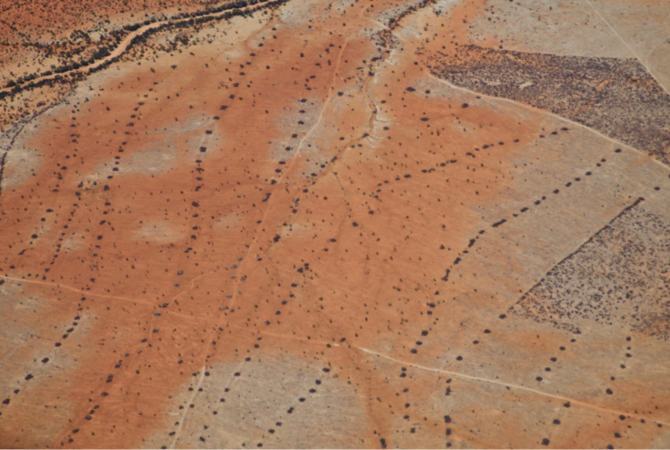 Namibia from the air. (Notice the dry riverbed and fractal vegetation patterns, indicating underground water. In Namibia, on average, it rains less than five inches per year.)
Namibia from the air. (Notice the dry riverbed and fractal vegetation patterns, indicating underground water. In Namibia, on average, it rains less than five inches per year.)
The quest for peace, for healing, for health and resilience is a quest for recognizable, exquisitely beautiful, self-replicating patterns of reciprocity. Robust biomimetic social and economic models show us where there are tears in the tattered bio-fabric of Western culture– the information gaps, the silent zones, the extinctions, the disease patterns, the crime statistics and, yes, the global system of banking and commerce. We need to re-learn to see and engage with what feeds and sustains all Life rather than what we can extract for profit.
Those who negotiate business deals, trade agreements and peace treaties, those who pass laws and create media do not include, much less satisfy, the communities affected by their actions. The stakeholders at the wide base of the social pyramid and the even vaster base of the ecological pyramid, i.e. those most directly and deeply affected by the decisions made by the small subset of white males within the subset of a single species at the pyramid’s top are not asked for their input. Unintended consequences are simply the cost of doing business. The individuals, the communities (human and non) who are inevitably or intentionally excluded become invisible, voiceless. But without those ‘invisibles,’ Life could not continue. And, those voiceless invisible ones must live the consequences of top-down decisions day by interminable day, seeing their killers on every street corner. Mahmoud Darwish wrote: You wonder: What kind of a linguistic or legal wunderkind could formulate a peace treaty and good neighborliness between a palace and a shack, between a guard and a prisoner? I would add: between a human and a tree? What would the mice tell us if we asked them? And the whales, and the fungi? Imagine what might happen if developers consulted the ancestors of a plot of land; spoke with potential occupants of a building; or considered the effect of the materials they use on sub-soil microbes. Imagine if peace treaties pondered seven generations hence, along with the unquiet dead, the widows and orphans, the traumatized veterans, and the displaced masses, including devastated forests and threatened species squeezed into fragments of degraded and diminished habitat. A whole new paradigm of negotiation must be re-invented, one that considers the Whole first and foremost, and includes All Beings across time.
A group of people I know is working feverishly (ha) to restore the Earth’s pre-global-warming temperature within the next twenty years by mechanically removing carbon from the atmosphere. They want our children and grandchildren to have the climate we were born with. I support and applaud them. They have gathered the world’s most brilliant minds and are busily calculating metric tons of sequesterable carbon, cap-and-trade schemes, carbon injection, and other strategies, economic, political and scientific, for removing enough carbon over the next 20 years to bring the global CO2 level down to 300 ppm. They have at their fingertips every conceivable statistical and financial argument to make it not only possible but irresistible for everyone, of every political stripe, to embrace mechanical and natural removal of carbon from the atmosphere and a warp-speed switch to renewables. I love them for their brilliance and especially for their fierce devotion. And yet… theirs is a mechanized solution that relies on science, politics, and unsustainable, unforgivable, western economic models in order to achieve the impossible by attempting to solve the problems we created from within the old paradigm of separation and dominion. I assume that this mechanistic scrambling is, at its heart, a howl of grief, and the manic calculations are choruses of praise. And, yet, the machinery of carbon sequestration would be enhanced immeasurably – and may not work without – a relational shift as well. The Earth is a Sentient Being. Mechanization of our relationship to her has caused lethal harm. She/He/It/We are her body. We are one of countless expressions of Life’s intricate infinity, interacting with itself. We can and must remember how to live from that understanding.
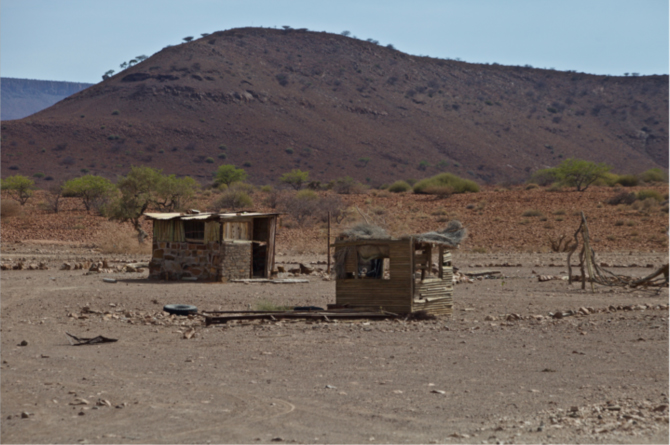 Homes in the desert, Damaraland, Namibia
Homes in the desert, Damaraland, Namibia
As we begin to awaken from the trance of materialism and the myth of the rugged individual, the imperatives of deep ecological and social change seem overwhelming. We do what we can, but it’s often hard to feel the tangible, cumulative reach of each ameliorative gesture day to day: that bottle we recycle, that thing we don’t buy, that ride we share… playing music to whales.
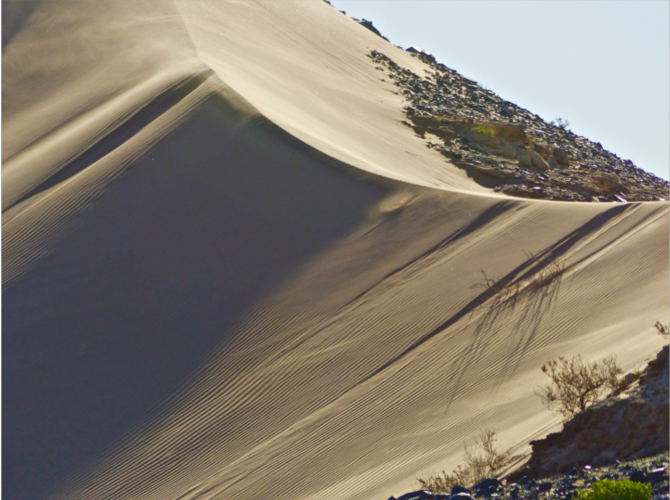 Sand dune, Namibia
Sand dune, Namibia
But in modern times, we have not, as a way of living, expressed our devotion to Earth. She is suffering without us, and we without Her. We do not know– have not studied and pay no attention to– what is possible when we remember that the Earth is alive and sentient beyond our imagining. We have not sought to engage with the responsive capacity of the Earth in order to find out what healing could occur if we were to humbly seek alliance with Her by singing Her praises, asking Her permission, and requesting Her guidance. Now that the Doomsday Clock has moved intolerably close to midnight, it’s time to find out.
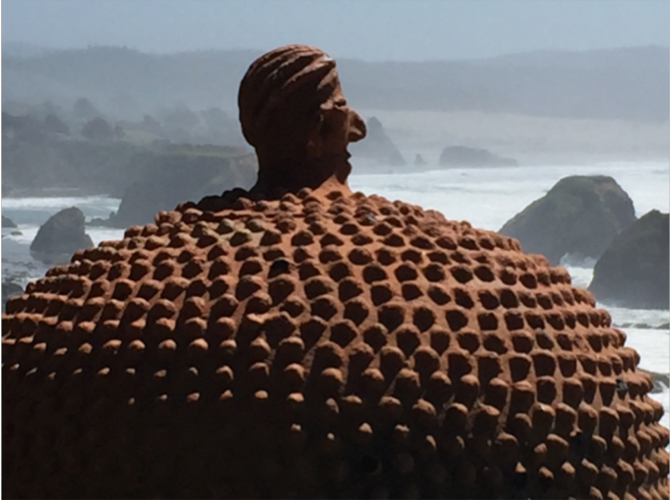 West African sculpture, Mendocino Coast
West African sculpture, Mendocino Coast
About the Author
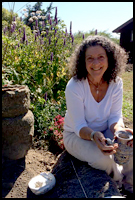
Cynthia Travis – is a writer and documentary filmmaker, and is Founder & President of the non–profit peacebuilding organization everyday gandhis (www.everydaygandhis.org). Since 2004, peacebuilders from everyday gandhis have been working with traditional communities, women and ex-combatants in Liberia, West Africa, and with selected schools and communities in the US. All projects arise from dreams and community dialogue. She recently launched the new blog, Earth Altar (www.earth-altar.org). In a former life she was a teacher and mediation trainer for children in California and New Mexico. She lives on the Mendocino Coast.
Return to top